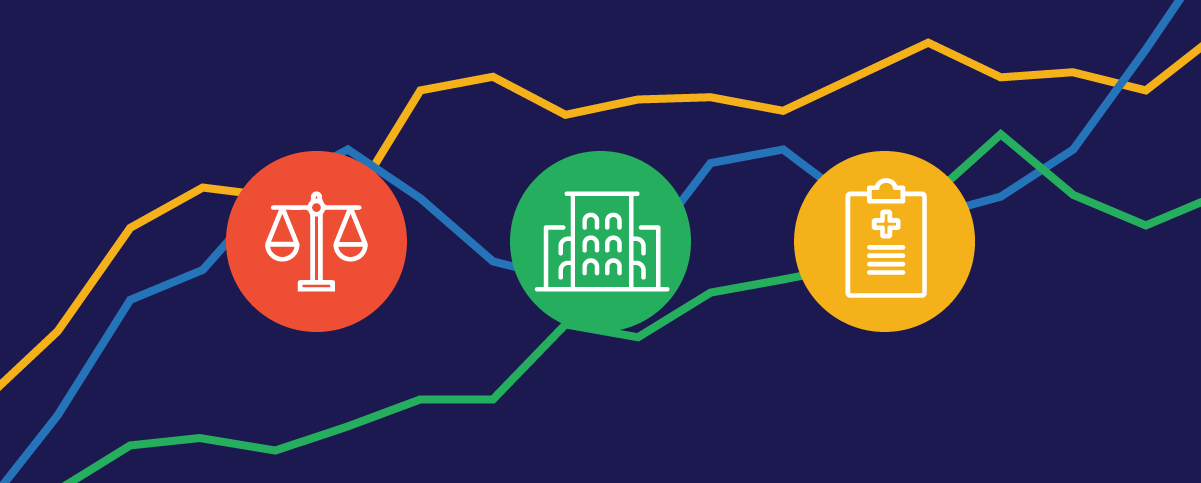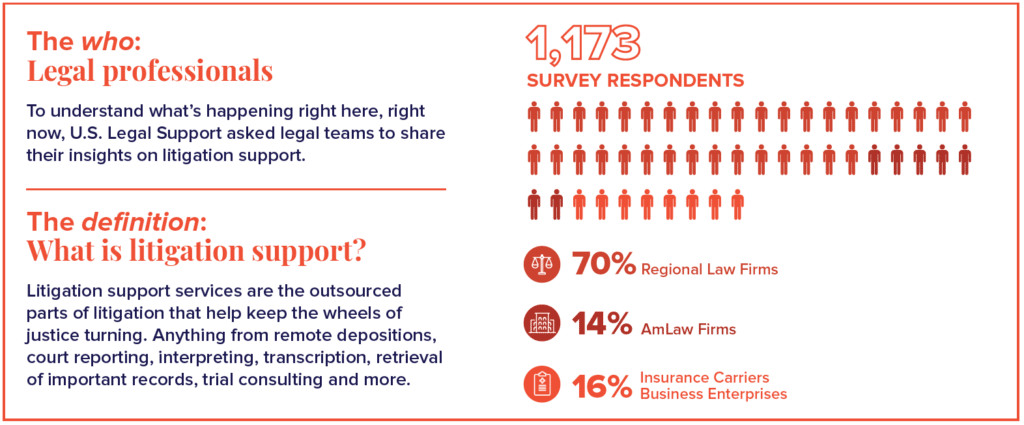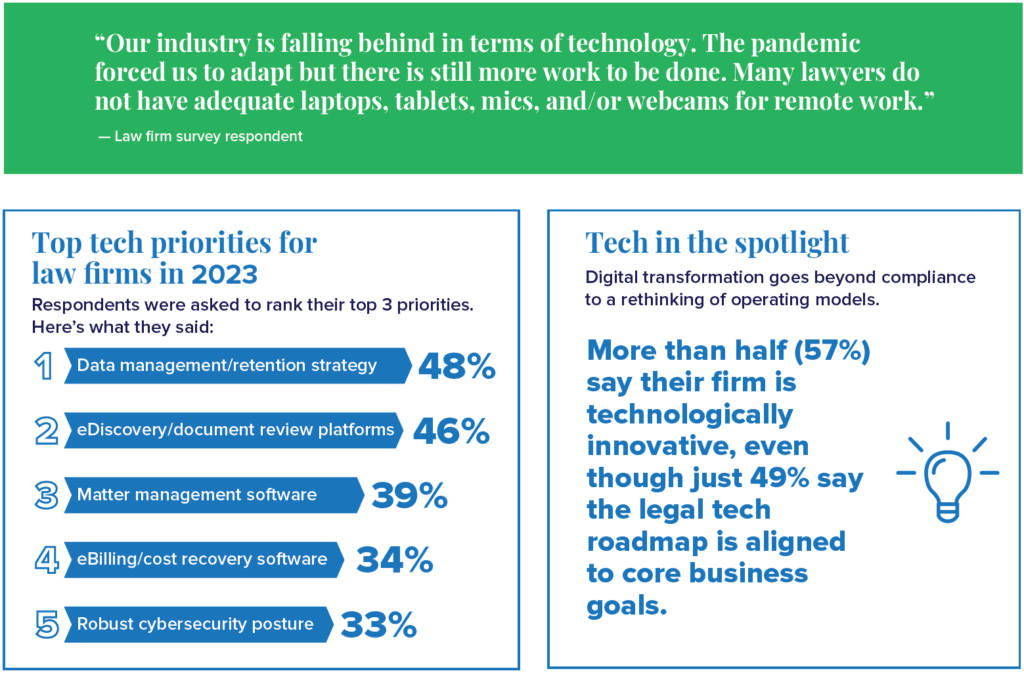The Results are in! All About our Litigation Support Trends Survey

In August of 2022, U.S. Legal Support conducted a multi-week survey on how things stand in the legal industry and how law firms, insurance carriers, and enterprise corporations leverage litigation support services. The results validated much of what we already knew about the legal industry landscape, but we found the core industry themes of the results primarily broke down into four main categories:
- Legal technology trends
- Vetting/selection of litigation support providers
- Remote work
- Cybersecurity
Over the course of the coming weeks, U.S. Legal Support will do a “deeper dive” into the core themes on our blog. Today, we’re unveiling the survey results in a shareable infographic, and looking at the results through the lens of the top legal technology trends heading into next year.
→ For full survey results, download the litigation support trends infographic:
Legal Tech Trends for 2023: Four Topics for Law Firms to Track
How true is the stereotype of legal being outdated and tech-averse? We set about finding out in the U.S. Legal Support 2023 Litigation Support Trends survey. Being prepared to capitalize on emerging legal technology trends can give law firms a competitive advantage. But let’s face it, law firms have not amassed a stellar reputation for being technically advanced. In its recent examination of legal tech trends, Gartner notes, “Legal and compliance teams have rarely been frontrunners to modernize, digitalize, and automate.” U.S. Legal Support asked more than 1,000 attorneys and legal professionals to rate the level of innovation at their organization.

With litigation volume ramping up, turning attention to what comes next in legal tech can be a challenge. As one Chief Litigation Officer noted, “It’s expensive and difficult to know what to do to keep ahead of the game with technology.”
That said, survey respondents gave their organizations high ratings on their ability to navigate legal technology. More than half (57%) agree their firm is technologically innovative, and a quarter (25%) strongly agree that their firm is technologically innovative. That’s a positive sign, especially considering that legal tech budgets are increasing exponentially relative to department spending. Making the most of your investment necessitates a thorough understanding of the future of legal technology.

Legal Technologies in the Spotlight
From artificial intelligence (AI) in law to automated legal operations, our survey asked legal professionals which legal tech tools and initiatives top the list of the highest priorities in 2023. What we discovered is that maintaining safe, secure, and efficient legal operations takes priority over digital transformation.
Top 5 Legal Tech Priorities
1. Data management/retention strategy 52%*
2. eDiscovery/document review platforms 48%
3. Matter management software 41%
4. eBilling/cost recovery software 36%
5. Robust cybersecurity posture 34%
*Percentages reflect the proportion of survey takers who ranked the legal tech initiative as a top three priority.
Practicality takes precedence. U.S. Legal Support Chief Information Officer, Lee Wielenga, explains, “It’s important to match your legal tech investments to the on-the-ground reality. For many firms, that’s strengthening data governance, adjusting to remote and hybrid proceedings, and reining in cybersecurity risk. Match the solution to the challenges, rather than deploying legal technology in search of a problem.”
Four Legal Tech Trends to Watch
Let’s take a closer look at where the legal tech industry is heading in 2023 and beyond. Keep your eye on these four legal tech trends. If your firm hasn’t initiated discussions about how to keep up, you may be playing catch-up.
1. AI law: the next frontier
2. Automation: build or buy?
3. Tech’s impact on client engagement
4. Demands for transparency
1. Artificial Intelligence and the Law: The Next Frontier
The potential benefits of AI in law are real and ready for prime time. In the annual ABA Profile of the Legal Profession, 36% of lawyers say that AI legal tools will be mainstream within the next five years. And yet—only 10% of lawyers say their firms are currently using artificial intelligence tools.
In our survey, we found limited prioritization of AI in the legal profession. Enterprise legal departments were far more likely to deploy AI or machine learning than their law firm counterparts, suggesting greater organizational maturity in these disciplines. But the AI wave is coming.
An article on “law bots” in the American Bar Association explores how AI is reshaping the legal profession: “It can increase attorney productivity and avoid costly mistakes. In some cases, it can also grease the wheels of justice to increase the speed of research and decision-making.” Here are some practical examples of usage of machine learning and AI in law firms:
- AI for Legal Research: Companies such as LexisNexis and WestLawEdge leverage AI—or perhaps more accurately, supervised machine learning—to help attorneys research thousands of instances of case law with ease.
- Automating Common Tasks: From contracts to compliance, machine learning and AI can help reduce the time-intensive tasks necessary to run any legal enterprise. For example, inefficiencies in contract processes lead to lost deals and higher risks; AI speeds up processing by quickly identifying non-standard language.
- Predictive Analysis: The advent of AI law means “…lawyers have more than just their instincts and experience to rely on when predicting things like litigation outcomes, future risk and legal spend.” Look for AI to play a role in jury research consulting, pre-litigation claims analysis, and internal resourcing.
2. Automation: Build or Buy?
Increased adoption of technology in pursuit of automated legal operations offers both operational and financial benefits. Automation reduces the time spent on routine tasks and enables greater focus on the higher-value (and higher margin) activities at the heart of the law firm.
Automation is often associated with artificial intelligence, but legal teams may seek other avenues beyond investing in in-house tech tools to bump up their efficiency quotient. For example, we’re seeing a trend towards the outsourcing of baseline functions.
This move is heightened by client pushback for more accountability, leading to increased interest in alternative legal service providers (ASLPs) and third-party litigation support firms. U.S. Legal Support Director of Enterprise Sales Patrick Gleason calls out the “inevitable integration of business rigor and analytics into law departments” in an examination of influences shaping corporate law, but the same principles hold true for law firms.
Cost savings can be achieved by a carefully considered combination of technology and support partners, particularly those who offer multiple service offerings with national reach. Functions ripe for automation include:
- Automated Translations: Machine translation technology utilizes artificial intelligence to automatically translate documents in record time and at a fraction of the cost of other methodologies.
- Transcription Support: The legal industry is one where a “paper trail” is always necessary. AI technologies can assist with legal transcriptions for court proceedings, bodycam footage, phone calls, and more into evidence needed for litigation.
3. Tech’s Impact on Client Engagement
Customer experience is a concept whose time has come for the legal sector, forcing a reexamination of data-driven practices and tech tools, from social media and client portals to voice-of-the-customer research. Principles that are traditionally used to predict consumer desires could be channeled for the development of new solutions and strategies.
“The industry’s accelerating metamorphosis is catalyzed by and focused on customers,” according to a Forbes article. “Digital transformation has become an existential imperative of corporate viability. Only a handful of legal functions have joined in those journeys, but that’s changing.”
Law firms must cultivate a deeper understanding of the user experience to capture market and mindshare. The advocacy group Law 2023 calls out several trends that “…represent a chance to build a legal industry that is radically more responsive to the demands of clients as well as society.” They include:
- Competition from legal outsiders disrupting traditional models with “radically lower costs”
- Research and development departments that use product development methodologies to explore new ways of practicing law
- “Innovation pipelines” around industry specialization used to proactively market to clients
4. Demands for Transparency
Finally, a broad-based trend to note is increasing desires for more transparency, and hence more accountability, across diverse segments of the legal landscape. Demands for accessible, real-time legal proceedings are dramatically altering public and private legal settings. For example:
- According to Pew research, the pandemic rapidly accelerated the adoption of digital tools to streamline court processes, from filings and discovery to trial and resolution
- The Judicial Conference of the U.S. has undertaken a national pilot to study the feasibility of livestreaming audio of court proceedings in district and bankruptcy courts
- In the U.S. Legal Support survey, 70% of respondents say that depositions are currently handled remotely in their organization
The ripple effects reach into law firms’ operating expense budgets. U.S. Legal Support examines the systems, tools, and tactics required to make the most of remote and hybrid proceedings in a recent white paper. A remote litigation technology platform like RemoteDemoTM also offers a secure solution that supports the journey to transparency.
Legal Tech Trends Takeaways
Technology is only as effective as your law firm’s ability to implement and optimize it. Legal professionals may be dubious that technology can replace human insight and decision-making on any matter. As one of our surveyed attorneys noted, “Some things are better left to the actual humans working on the case.” But the world is shifting. Keeping an eye on legal trends for 2023 is an appropriate exercise and business imperative for leaders looking to do more with less.
“Technology for technology’s sake isn’t a viable strategy for law firms to attract and engage clients,” says Jimmie Bridwell, CEO of U.S. Legal Support. “Our goal as an engaged partner is to help our clients serve their own customers more effectively through the targeted application of innovative solutions and streamlined support.”
For more information on U.S. Legal Support research and services, reach out today.
→ For full survey results, download the litigation support trends infographic:
Editoral Policy
Content published on the U.S. Legal Support blog is reviewed by professionals in the legal and litigation support services field to help ensure accurate information. The information provided in this blog is for informational purposes only and should not be construed as legal advice for attorneys or clients.


